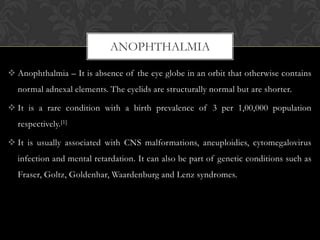The Rare Condition Of Bilateral Anophthalmia: Medical Advancements And Future Outlook

Table of Contents
Understanding the Causes and Diagnosis of Bilateral Anophthalmia
Bilateral anophthalmia, also known as congenital anophthalmia or ocular aplasia, refers to the absence of eyes at birth. Differentiating it from microphthalmia (small eyes), bilateral anophthalmia signifies a complete lack of eye development. Understanding its etiology is crucial for effective management and potential prevention.
Genetic Factors
Genetic mutations play a significant role in many cases of bilateral anophthalmia. Genetic testing can identify chromosomal abnormalities and specific gene mutations responsible for this condition. Several genes have been implicated, highlighting the complexity of the genetic landscape.
- Specific Syndromes: Several syndromes are linked to anophthalmia, including those associated with mutations in the SOX2 gene, which plays a crucial role in eye development. Other genetic syndromes can also present with anophthalmia as one of their features.
- Prenatal Genetic Counseling: Prenatal genetic counseling and testing are vital for families with a history of anophthalmia, enabling informed reproductive decisions. Early diagnosis allows for preparation and access to appropriate support services.
- Importance of Early Diagnosis: Early identification of bilateral anophthalmia facilitates timely intervention, enabling parents and caregivers to implement strategies to support the child's development.
Environmental Factors
While genetic factors are prominent, environmental influences during pregnancy may also contribute to bilateral anophthalmia. These environmental factors, known as teratogens, can disrupt fetal development. However, pinpointing specific environmental causes remains challenging.
- Maternal Factors: Maternal health is a crucial factor. Exposure to certain infections during pregnancy, maternal drug use (including some prescription medications), and exposure to toxins can potentially increase the risk.
- Limitations in Identification: The precise role of environmental factors in causing bilateral anophthalmia is often difficult to ascertain. Many cases remain idiopathic, meaning the cause is unknown.
Current Medical Interventions and Support for Individuals with Bilateral Anophthalmia
Currently, medical interventions focus on improving quality of life and addressing the challenges posed by the absence of eyes.
Prosthetic Eyes
Ocular prostheses, commonly known as artificial eyes, play a significant role in enhancing the appearance and facilitating social interaction for individuals with bilateral anophthalmia. These prostheses are custom-made to match the individual's skin tone and facial features.
- Types and Materials: Prosthetic eyes are crafted from various materials, such as acrylic or glass, offering different levels of realism and durability. The selection depends on individual needs and preferences.
- Fitting and Maintenance: Fitting a prosthetic eye involves a meticulous process ensuring proper comfort and aesthetics. Regular maintenance and cleaning are necessary to preserve its appearance and hygiene.
- Psychological Aspects: The psychological and emotional impact of using prosthetic eyes should be considered. Support from professionals, including ophthalmologists and psychologists, is essential to ensure positive adaptation.
Sensory Aids and Assistive Technologies
To navigate their daily lives effectively, individuals with bilateral anophthalmia rely on various assistive technologies and sensory aids.
- Mobility Aids: Canes, guide dogs, and other mobility aids enhance independence and safety for those with this condition. Orientation and mobility training is crucial to develop efficient navigation skills.
- Sensory Substitution: Sensory substitution devices, such as echolocation training, help individuals compensate for the lack of vision by utilizing other senses. These techniques require specialized training and practice.
- Early Intervention: Early intervention is critical for developing adaptive skills, maximizing independence, and fostering social inclusion.
Future Directions and Research in Bilateral Anophthalmia Treatment
The field of regenerative medicine offers hope for future treatments. Research into novel therapies focuses on potential solutions to replace or repair missing eye structures.
Stem Cell Therapy
Stem cell research holds significant promise for treating bilateral anophthalmia. The potential of stem cells to differentiate into various eye tissues offers hope for eye regeneration.
- Current Status: While research is ongoing, clinical trials are still in early stages. The complexity of eye development makes it a challenging field of study.
- Animal Studies: Promising results have been obtained from animal studies, indicating the potential for stem cell therapy to induce eye tissue regeneration.
- Challenges and Limitations: Challenges remain in terms of successfully differentiating stem cells into functional eye tissues and integrating them into the existing anatomy.
3D Bioprinting
3D bioprinting technology is revolutionizing tissue engineering, presenting exciting possibilities for creating artificial eyes. This cutting-edge technology allows for the precise fabrication of complex structures.
- Potential for Functional Eyes: The goal is to develop bioprinted eyes that are not only aesthetically pleasing but also functional, restoring some visual capability.
- Current Research: Research is focusing on the development of bioinks compatible with eye tissues, building upon progress made in 3D bioprinting of other organs.
- Ethical Considerations: Ethical considerations surrounding the use of 3D bioprinted tissues and the potential for misuse need careful evaluation.
Conclusion
Bilateral anophthalmia presents unique challenges, requiring comprehensive medical and psychosocial support. While currently available interventions focus on improving quality of life, the future holds immense potential for more transformative treatments. Emerging technologies like stem cell therapy and 3D bioprinting offer hope for regenerating eye tissues or creating functional artificial eyes. Learning more about bilateral anophthalmia and supporting research into its treatment is crucial for improving the lives of those affected. Continue your exploration of bilateral anophthalmia resources to learn more.

Featured Posts
-
 Meet Manon Fiorot Frances Next Ufc Champion
May 11, 2025
Meet Manon Fiorot Frances Next Ufc Champion
May 11, 2025 -
 The Value Of Middle Managers Bridging The Gap Between Leadership And Workforce
May 11, 2025
The Value Of Middle Managers Bridging The Gap Between Leadership And Workforce
May 11, 2025 -
 Dzhessika Simpson I Ee Put K Stroynosti Sovety I Vdokhnovenie
May 11, 2025
Dzhessika Simpson I Ee Put K Stroynosti Sovety I Vdokhnovenie
May 11, 2025 -
 Unlocking Profitable Returns A Simple Dividend Investing Strategy
May 11, 2025
Unlocking Profitable Returns A Simple Dividend Investing Strategy
May 11, 2025 -
 Jose Aldo L Adaptateur Pour Continuer D Avancer
May 11, 2025
Jose Aldo L Adaptateur Pour Continuer D Avancer
May 11, 2025
